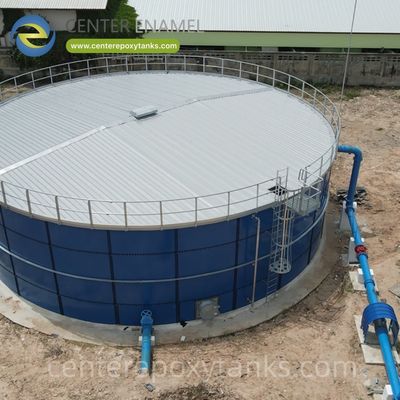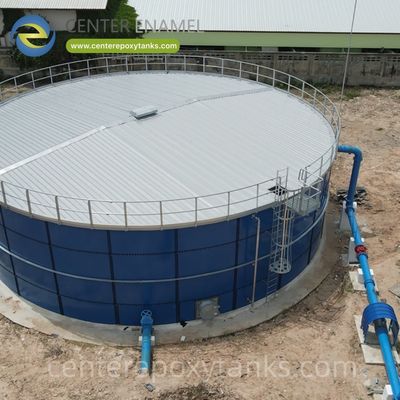-
Vetro fuso a serbatoi di acciaio (419)
-
carri armati di acciaio inossidabile (372)
-
La fusione ha legato i carri armati a resina epossidica (424)
-
Serbatoi in acciaio galvanizzato (321)
-
Tetti di alluminio della cupola (753)
-
Serbatoi di stoccaggio delle acque reflue (226)
-
serbatoi di acciaio saldato (297)
-
Contenitori a pressione (295)
-
Digestore anaerobico (201)
-
Serbatoi di acqua industriali (349)
-
Serbatoi in acciaio rivestiti di vetro (180)
-
Serbatoi di acciaio serrati (181)
-
Serbatoio del fango (115)
-
Serbatoio del biogas (173)
-
Serbatoi di stoccaggio di lixiviazione (133)
-
Serbatoi di stoccaggio dell'acqua agricola (179)
-
Serbatoio dell'acqua di fuoco (166)
-
Silos di stoccaggio del grano (130)
-
Progetti di biogas (349)
-
Progetti di trattamento delle acque reflue (270)
-
Tetti a doppia membrana (177)
Serbatoio in epoxy a legame fuso per acque reflue di cartiera: una soluzione robusta per flussi di rifiuti altamente acidi
| Luogo di origine: | Cina |
| Marca: | CEC TANKS |
| Certificazione: | ISO 9001:2008, AWWA D103 , OSHA , BSCI |
| Numero di modello: | J2016012311 |
| Quantità di ordine minimo: | 1Set |
| Prezzo: | $5000~$20000 one set |
| Imballaggi particolari: | PE POLY-FOAM tra ciascuna due piastre in acciaio; pallet in legno e scatola di legno |
| Tempi di consegna: | 0-60 giorni dopo il deposito ricevuto |
| Termini di pagamento: | L/c, t/t |
| Capacità di alimentazione: | 60 set al mese |
|
Informazione dettagliata |
|||
| Luogo di origine | Cina | Marca | CEC TANKS |
|---|---|---|---|
| Certificazione | ISO 9001:2008, AWWA D103 , OSHA , BSCI | Numero di modello | J2016012311 |
| Gamma di pH: | Un foglio di grado pH : 3-11, foglio di grado AA PH: 1-14 | Spessore del rivestimento: | due rivestimenti interni ed esterni |
| Resistenza alla corrosione: | eccellente ! Adatto per acqua di sale d'acqua reflue, acqua di mare, olio di greggio ad alto zol | Adesione: | 3.450n/cm |
| Permeabilità: | gas e liquido impermeabile | vita seriva: | Più di 30 anni |
| Evidenziare: | serbatoio per acque reflue in resina epossidica a legame di fusione,serbatoio di stoccaggio in epoxy resistente agli acidi,serbatoio di contenimento in epoxy per cartiera |
||
Descrizione del prodotto
Serbatoio in resina epossidica a legame di fusione per acque reflue di cartiera: una soluzione robusta per flussi di rifiuti altamente acidi
La produzione di pasta di legno e carta è un processo industriale intensivo che genera uno dei flussi di acque reflue più impegnativi dal punto di vista chimico nel settore manifatturiero.Acque reflue di cartiera è caratterizzato da livelli estremamente elevati di domanda chimica di ossigeno (COD), composti organici complessi (come lignina e fibre di cellulosa) e, in modo critico, livelli di pH volatili guidati dall'uso di acidi forti e sostanze chimiche caustiche nei processi di cottura e sbiancamento. Questo ambiente richiede un contenitore in grado di fornire una soluzione robusta per flussi di rifiuti altamente acidi—una struttura impermeabile alla corrosione e che mantiene la sua integrità sotto continuo attacco chimico. Il Serbatoio in resina epossidica a legame di fusione (FBE) è progettato per offrire questa necessaria resilienza. Presso Shijiazhuang Zhengzhong Technology Co., Ltd. (Center Enamel), utilizziamo serbatoi in acciaio imbullonati FBE per garantire un contenimento sicuro e a lungo termine, fornendo le fondamenta durevoli richieste per una gestione conforme e sostenibile di questo aggressivo effluente industriale.
L'estrema corrosività degli effluenti di cartiera
L'infrastruttura di contenimento nell'industria della pasta di legno e della carta deve essere specificamente progettata per gestire una combinazione unica di fattori di stress chimici e fisici:
Fluttuazione estrema del pH: Le fasi di cottura e sbiancamento della produzione di pasta di legno comportano l'uso sequenziale di acidi forti (come l'acido solforico) e basi forti (come l'idrossido di sodio). L'effluente risultante passa violentemente da altamente acide a altamente caustico, deteriorando rapidamente i materiali che mancano di una completa resistenza chimica.
Elevato carico organico e tossico: Lignina, zuccheri del legno e fibre di pasta di legno disciolte contribuiscono a un carico organico estremamente elevato. Sebbene non direttamente corrosivo, questo carico richiede un trattamento biologico su larga scala e i serbatoi di contenimento non devono inibire le sensibili popolazioni microbiche.
Temperature elevate: Le acque reflue vengono spesso scaricate dalle linee di processo ad alte temperature. Questo calore accelera la velocità di reazione chimica e la corrosione, richiedendo un rivestimento che mantenga la sua integrità e adesione sotto stress termico.
Solidi abrasivi: L'effluente contiene trucioli di legno residui, fibre di carta e riempitivi minerali. Nel tempo, questi solidi sospesi causano abrasione meccanica, in particolare in corrispondenza degli ingressi e dei punti di scarico, rappresentando una minaccia costante per le superfici in acciaio non protette.
Affidabilità strutturale: Le cartiere sono operazioni continue e ad alto volume. Il guasto di un singolo contenitore può portare a gravi rilasci ambientali e a massicci tempi di inattività della produzione, rendendo robusta l'integrità strutturale un requisito non negoziabile.
Una soluzione robusta deve fornire una barriera permanente e uniforme contro l'esposizione continua a flussi di rifiuti volatili e flussi di rifiuti altamente acidi.
La soluzione FBE: una soluzione robusta per flussi di rifiuti altamente acidi
I serbatoi in acciaio imbullonati in resina epossidica a legame di fusione di Center Enamel sono progettati per resistere alle estreme esigenze chimiche delle acque reflue di cartiera, affermandosi come una soluzione robusta per flussi di rifiuti altamente acidi attraverso vantaggi fondamentali di materiale e design:
Resistenza chimica senza compromessi: Il rivestimento FBE è un polimero termoindurente ad alta densità che è legato molecolarmente al substrato in acciaio. Questa barriera specializzata è chimicamente inerte, fornendo una resistenza superiore e a lungo termine all'intero spettro di acidi, caustici e sostanze chimiche organiche presenti nell'ambiente della cartiera, superando di gran lunga le prestazioni dei rivestimenti applicati con liquidi standard.
Integrità strutturale e durata: Costruiti in acciaio ad alta resistenza ingegnerizzato in fabbrica, i serbatoi FBE possiedono la robusta resistenza strutturale necessaria per gestire in sicurezza l'immenso carico idraulico di bacini di equalizzazione e trattamento di grandi volumi, garantendo decenni di servizio affidabile nell'industria pesante.
Stabilità termica: Il rivestimento FBE viene applicato in un ambiente controllato in fabbrica ad alta temperatura, con conseguente finitura che mantiene il suo legame strutturale e l'inerzia chimica anche quando esposto allo scarico intermittente ad alta temperatura dai processi della cartiera.
Superficie igienica e non porosa: La finitura FBE liscia e non porosa resiste all'accumulo di fibre organiche appiccicose e biofilm, il che è fondamentale per un funzionamento efficiente e una manutenzione ridotta nelle fasi di equalizzazione e trattamento biologico.
Distribuzione rapida e modulare: Il design imbullonato consente una costruzione modulare significativamente più veloce rispetto al calcestruzzo tradizionale. Ciò consente alle cartiere di implementare o espandere rapidamente la capacità di trattamento critica con un'interruzione minima del sito e tempi di inattività.
Applicazione del settore dei prodotti: serbatoi FBE nel trattamento delle acque reflue di cartiera
La resistenza specializzata del serbatoio FBE lo rende ideale per diverse fasi critiche nella gestione delle acque reflue di cartiera, garantendo la conformità e la continuità operativa:
Bacini di equalizzazione e neutralizzazione: I serbatoi FBE vengono utilizzati per il contenimento iniziale degli effluenti grezzi, dove la loro resistenza alle oscillazioni volatili altamente acide e alcaline è fondamentale per stabilizzare il flusso di rifiuti prima che passi alle fasi biologiche sensibili.
Stoccaggio di liquori di cottura e sbiancamento: I serbatoi forniscono uno stoccaggio sicuro e non corrosivo per i liquori di cottura usati (liquore nero) o le sostanze chimiche di sbiancamento esaurite, dove l'attacco chimico è più aggressivo.
Bacini di aerazione e reattori biologici: Nelle enormi vasche richieste per il trattamento aerobico, i serbatoi FBE offrono una piattaforma inerte e ad alta integrità che supporta la salute della biomassa resistendo agli effetti corrosivi dei gas disciolti e dei residui chimici.
Disidratazione e stoccaggio dei fanghi: I serbatoi vengono utilizzati per lo stoccaggio sicuro di fanghi ad alto contenuto di solidi e residui di cenere, con il rivestimento FBE che protegge l'acciaio di base dalla materia particolata corrosiva.
Acqua di processo e soppressione incendi: I serbatoi FBE vengono utilizzati anche in tutta la cartiera per lo stoccaggio di acqua di processo non potabile e riserve vitali di acqua antincendio, fornendo una fonte costante e priva di corrosione.
Casi di studio di progetti: serbatoi FBE nel trattamento delle acque reflue di cartiera
Center Enamel ha una vasta esperienza nella fornitura di robusta di contenimento per ambienti industriali chimicamente aggressivi, tra cui l'industria della pasta di legno e della carta, confermando la nostra capacità di gestire flussi di rifiuti altamente acidi.
| Descrizione del progetto | Scala e quantità del progetto |
| Progetto di trattamento delle acque reflue della cartiera di Guangdong | Questa installazione su larga scala consisteva in 2 unità con una capacità totale di 10.230 metri cubi, fornendo un contenimento essenziale e chimicamente robusta per gli effluenti corrosivi di lavorazione della pasta di legno. |
| Progetto di trattamento delle acque reflue della cartiera di Hubei Xiangyang | Un progetto industriale critico che utilizza 1 unità con una capacità totale di 1.226 metri cubi, progettato per l'elevato carico organico e le esigenze corrosive delle acque reflue di fabbricazione della carta. |
| Progetto di acque reflue di fabbricazione della carta di Zhejiang Taizhou | Abbiamo fornito un serbatoio ad alte prestazioni composto da 1 unità con una capacità totale di 1.023 metri cubi, garantendo lo stoccaggio e la capacità di trattamento sicuri e a lungo termine per i rifiuti di pasta di legno e carta. |
Il ruolo di Center Enamel nella conformità industriale pesante
Shijiazhuang Zhengzhong Technology Co., Ltd. (Center Enamel) si dedica a fornire infrastrutture industriali che soddisfano i più alti standard per il contenimento chimico e la conformità ambientale. I nostri serbatoi FBE per le acque reflue di cartiera sono fabbricati sotto stretto controllo di qualità, garantendo un rivestimento ad alte prestazioni legato molecolarmente che fornisce una difesa permanente contro l'attacco chimico. Scegliendo Center Enamel, i clienti investono in una soluzione robusta che mitiga gli alti rischi di guasto strutturale e perdite associati a flussi di rifiuti altamente acidi, garantendo decenni di funzionamento affidabile.
Conclusione: garantire l'integrità contro gli estremi chimici
La natura chimicamente aggressiva delle acque reflue di cartiera richiede un'infrastruttura di contenimento che sia fondamentalmente robusta. Il Serbatoio in resina epossidica a legame di fusione, con la sua resistenza chimica superiore, l'elevata resistenza strutturale e il design modulare, è la definitiva soluzione robusta per flussi di rifiuti altamente acidi. Fornisce all'industria della pasta di legno e della carta un bene a lungo termine che neutralizza la minaccia della corrosione dovuta agli estremi cambiamenti di pH, garantisce la continuità operativa e supporta gli obiettivi critici di conformità ambientale in uno dei settori più esigenti dal punto di vista chimico del mondo.
Per implementare un sistema di contenimento progettato per una resistenza superiore alle estreme esigenze chimiche e termiche degli effluenti di cartiera, scegli i serbatoi in acciaio imbullonati in resina epossidica a legame di fusione di Center Enamel. Contattaci oggi per proteggere la tua infrastruttura industriale essenziale.




